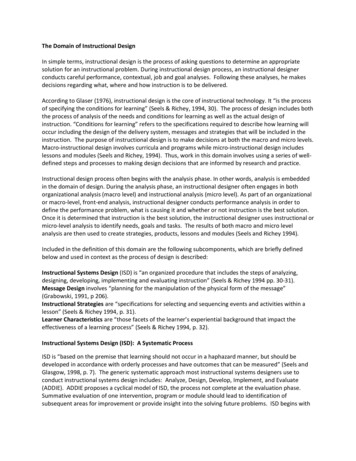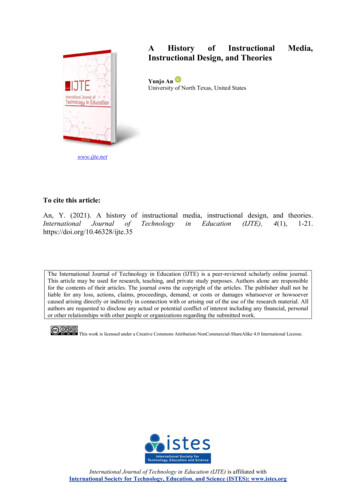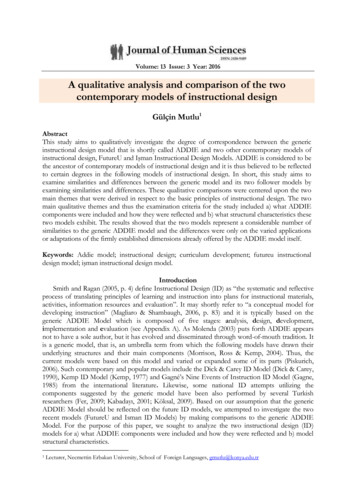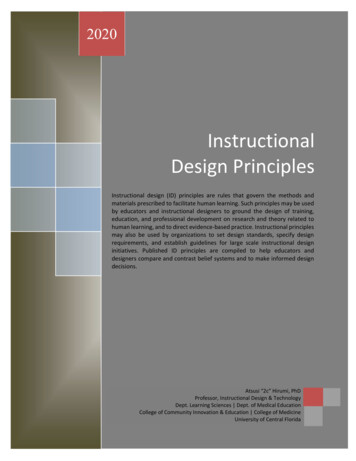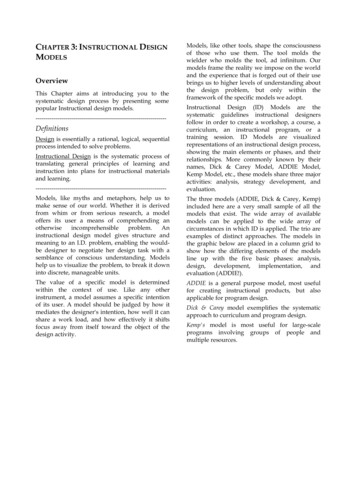
Transcription
CHAPTER 3: INSTRUCTIONAL DESIGNMODELSOverviewThis Chapter aims at introducing you to thesystematic design process by presenting somepopular Instructional design models.Models, like other tools, shape the consciousnessof those who use them. The tool molds thewielder who molds the tool, ad infinitum. Ourmodels frame the reality we impose on the worldand the experience that is forged out of their usebrings us to higher levels of understanding aboutthe design problem, but only within theframework of the specific models we ---------------------Instructional Design (ID) Models are thesystematic guidelines instructional designersfollow in order to create a workshop, a course, acurriculum, an instructional program, or atraining session. ID Models are visualizedrepresentations of an instructional design process,showing the main elements or phases, and theirrelationships. More commonly known by theirnames, Dick & Carey Model, ADDIE Model,Kemp Model, etc., these models share three majoractivities: analysis, strategy development, andevaluation.Models, like myths and metaphors, help us tomake sense of our world. Whether it is derivedfrom whim or from serious research, a modeloffers its user a means of comprehending anotherwiseincomprehensibleproblem.Aninstructional design model gives structure andmeaning to an I.D. problem, enabling the wouldbe designer to negotiate her design task with asemblance of conscious understanding. Modelshelp us to visualize the problem, to break it downinto discrete, manageable units.The three models (ADDIE, Dick & Carey, Kemp)included here are a very small sample of all themodels that exist. The wide array of availablemodels can be applied to the wide array ofcircumstances in which ID is applied. The trio areexamples of distinct approaches. The models inthe graphic below are placed in a column grid toshow how the differing elements of the modelsline up with the five basic phases: analysis,design, development, implementation, andevaluation (ADDIE!).The value of a specific model is determinedwithin the context of use. Like any otherinstrument, a model assumes a specific intentionof its user. A model should be judged by how itmediates the designer's intention, how well it canshare a work load, and how effectively it shiftsfocus away from itself toward the object of thedesign activity.ADDIE is a general purpose model, most usefulfor creating instructional products, but alsoapplicable for program ----------------------DefinitionsDesign is essentially a rational, logical, sequentialprocess intended to solve problems.Instructional Design is the systematic process oftranslating general principles of learning andinstruction into plans for instructional materialsand learning.Dick & Carey model exemplifies the systematicapproach to curriculum and program design.Kemp's model is most useful for large-scaleprograms involving groups of people andmultiple resources.
Figure 3.1: Instructional Design Models’ Chart16
The ADDIE ModelInstructional design is the systematic approach totheAnalysis,Design,Development,Implementation, and Evaluation of learningmaterials and activities.Instructional design aims for a learner-centeredrather than the traditional teacher-centeredapproach to instruction, so that effective learningcan take place. This means that every componentof the instruction is governed by the learningoutcomes, which have been determined after athorough analysis of the learners’ needs.These phases sometimes overlap and can beinterrelated; however, they provide a dynamic,flexible guideline for developing effective andefficient instruction.The ADDIE Model is an iterative instructionaldesign process, where the results of the formativeevaluation of each phase may lead theinstructional designer back to any previous phase.The end product of one phase is the startingproduct of the next phase.Figure 3.2: The ADDIE ModelSample TasksSample OutputAnalysisNeeds assessmentLearner profilethe process of defining what is to be learnedProblem identificationDescription of constraintsTask analysisNeeds, Problem StatementTask analysisDesignWrite objectivesMeasurable objectivesthe process of specifying how it is to be learnedDevelop test itemsInstructional strategyPlan instructionPrototype specificationsIdentify resourcesDevelopmentWork with producersStoryboardthe process of authoring and producing thematerialsDevelop workbook, flowchart,ScriptprogramExercisesComputer assisted instructionImplementationTeacher trainingStudent comments, datathe process of installing the project in the realworld contextTryoutEvaluationRecord time dataRecommendationsthe process of determining the adequacy of theinstructionInterpret test resultsProject reportSurvey graduatesRevised prototypeRevise activitiesKemp ModelThe oval shape of Kemp model (as depicted in the"original" diagram) gives the designer the sensethat the design and development process is acontinuous cycle that requires constant planning,design, development and assessment to insureeffective instruction. The model is systemic andnonlinear and seems to encourage designers towork in all areas as appropriate. For ease ofexplanation, the description of the model willstart in the innermost sphere at "twelve o'clock"and proceed clockwise: Identify instructional problems, and specifygoals for designing an instructional program. Examine learner characteristics that shouldreceive attention during planning. Identify subject content, and analyze taskcomponents related to stated goals andpurposes. State instructional objectives for the learner. Sequence content within each instructionalunit for logical learning. Design instructional strategies so that eachlearner can master the objectives. Plan the instructional message and delivery. Develop evaluation instruments to assessobjectives.
Select resources to support instruction andlearning activities.Revision encircles all nine elements of model. Thetwo outer ovals illustrate the feedback feature,which allows the designer to make changes in thecontent or treatment of elements at any timeduring the development cycle. The idea is toimprove any weak parts of the program as theyare discovered to better insure learners will beable to accomplish the instructional objectives at asatisfactory level.The nine elements form a logical, clockwisesequence. However, the starting point and orderin which the designer addresses the individualelements is not predetermined. The use of the ovalas a visual organizer underscores this purpose.Designers may use the model flexibly to suit theirown needs. The elements are not connected withlines or arrows, which would indicate a linear,sequential order. All programs or projects maynot require all nine elements.Steps Assessing Needs to Identify InstructionalGoal(s). Conducting a Goal Analysis. Identifying Subordinate Skills and EntryBehaviors. Analyzing Learners and Contexts. Writing Performance Objectives. Developing Assessment Instruments.The word element is used as a label to describeeach of the nine parts. In keeping with the nonlinear concept of the model, terms such as step,stage, level, or sequential item were deliberatelynot used. Developing an Instructional Strategy. Developing Instructional Materials. Designing andEvaluations.The modified Kemp ID Plan is a reconceptualization of Kemp's plan in order to fit the elementsinto the ADDIE schema. The undulating sequenceof the non-connected oval shapes are meant toconvey a similar idea as the original Kemp plan.The encircling ovals serve the same purpose as theoriginal plan. Revising Instructional Materials. Designing veIdentify instructional goals: What do you wantlearners to be able to do when they havecompleted the instruction?The Dick & Carey ModelOverviewHistorical position: It is based on the idea thatthere is a predictable and reliable link between astimulus (instructional materials) and theresponse that it produces in a learner (learning ofthe materials). The designer needs to identify thesub-skills the student must master that, inaggregate, permit the intended behavior to belearned and then select the stimulus and strategyfor its presentation that builds each sub-skill.Brief definition: The Dick and Carey modelprescribes a methodology for designinginstruction, based on a reductionist model ofbreakinginstructiondownintosmallercomponents. Instruction is specifically targeted onthe skills and knowledge to be taught andsupplies the appropriate conditions for thelearning of these outcomes.Conduct Instructional Analysis: InstructionalAnalysis refers to the procedures applied to aninstructional goal in order to identify the relevantskills and their subordinate skills and informationrequired for a student to achieve the goal (thepurpose is to determine the skills involved inreaching a goal).Identify entry behaviors and learners chatacteristics: A step-by-step determination of whatpeople are doing when they perform the goal andwhat entry behaviors are needed. Involvesidentification of the context in which the skillswill be learned and the context in which the skillswill be used.18
Write performance objectives: The purpose is totranslate the needs and goals into specific anddetailed objectives. This includes specific behaviorskills to be learned, the conditions under whichthey must be performed and the criteria forsuccessful performance.Develop Criterion – Reference Tests: Deriveassessment instruments based on the objectives to: Diagnose an individual’s possessions of thenecessary prerequisites for learning newskills Check the results of student learning duringthe process of a lesson Provide document of students progress forparents or administratorsIt is useful in evaluating the instructional systemitself (Formative/ Summative evaluation) and forearly determination of performance measuresbefore the development of lesson plan andinstructional materialsDevelop instructional strategy: Instructionalstrategy is an overall plan of activities to achievean instructional goal; it includes the sequence ofintermediate objectives and the learning activitiesleading to the instructional goal. Its purpose is toidentify the strategy to achieve the terminalobjective and to outline how instructionalactivities will relate to the accomplishment of theobjectives. Emphasis is given on presentation ofinformation, practice and feedback, and testing. Awell-designed lesson should demonstratingknow-ledge about the learners, tasks reflected inthe objectives, and effectiveness of teachingstrategies.Example.Choice of delivering methodology:Teacher-led, Group-paced vs. Learner-centered,Learner-paced.collect data and information that is used toimprove a program or produce; it is conductedwhile the program is still being developed. Thepurpose is to provide data for revising andimproving instructional materials. This includestesting of instructional materials in one-to-one,small groups or field evaluations so that thematerials can be evaluated with learners andexperts of the field.Revise instruction: The aim is to revise theinstruction so as to make it as effective as possiblefor larger number of students. Data from theformative evaluation are summarized andinterpreted to attempt to identify difficultiesexperience by learners in achieving the objectivesand to relate these difficulties to specificdeficiencies in the materials.Summative evaluation: Summative evaluation isan evaluation designed and used after aninstructional program has been implemented andformative evaluation completed. Its purpose is toconduct independent evaluation to judge theworth of the instruction and study theeffectiveness of the instruction system as a wholeand make recommendations about its adoption orretention. Summative evaluation is conducted: After the system has passed through itsformative stage In a small scale or large Scale For a short period or long periodKey termsNeeds assessment: The formal process ofidentifyingdiscrepanciesbetweencurrentoutcomes and desired outcomes for anorganizationPerformance objectives: A statement of what thelearners will be expected to do when they havecompleted a specified course of instruction, statedin terms of observable performancesSub-ordinate objectives: An objective that must beattained in order to accomplish a terminalobjective.Terminal objective: An objective the learner willbe expected to accomplish when they havecompleted a course of instructionDevelop and select instructional materials: Theaim is to produce instructional materials takinhinto account the instructional strategy that hasbeen adopted (e.g., should we use printed orelectronic media or both, to convey events ofinstruction?). Try to use of existing materialswhen this is possible. The role of teacher dependson the choice of delivery system)Develop and conduct formative evaluation:Formative evaluation is an evaluation designed toHierarchical analysis: Technique used with goalsin the intellectual skills domain to identify thecritical subordinate skills needed to achieve thegoal, and their inter-relationships.Instructional implications: Learning is based onmastering a set of behaviors which are predictableand therefore reliable. The correct instructionalanalysis and instruction will lead to demonstrableskills.19
ReferencesWalter Dick, Lou Carey, James O. Carey: TheSystematic Design of Instruction. Allyn & Bacon.2001, (5th Edition), ISBN: 0-321-03780-4.Kemp E., Morrison G. R., Ross S. M. (1996).Designing Effective Instruction, 2nd Edition.Upper Saddle River, NJ: Prentice-Hall.20
The ADDIE Model Instructional design is the systematic approach to the Analysis, Design, Development, Implementation, and Evaluation of learning materials and activities. Figure 3.2: The ADDIE Model Instructional design aims for a learner-centered rather than the traditional teacher-centered approach to instruction, so that effective learning





